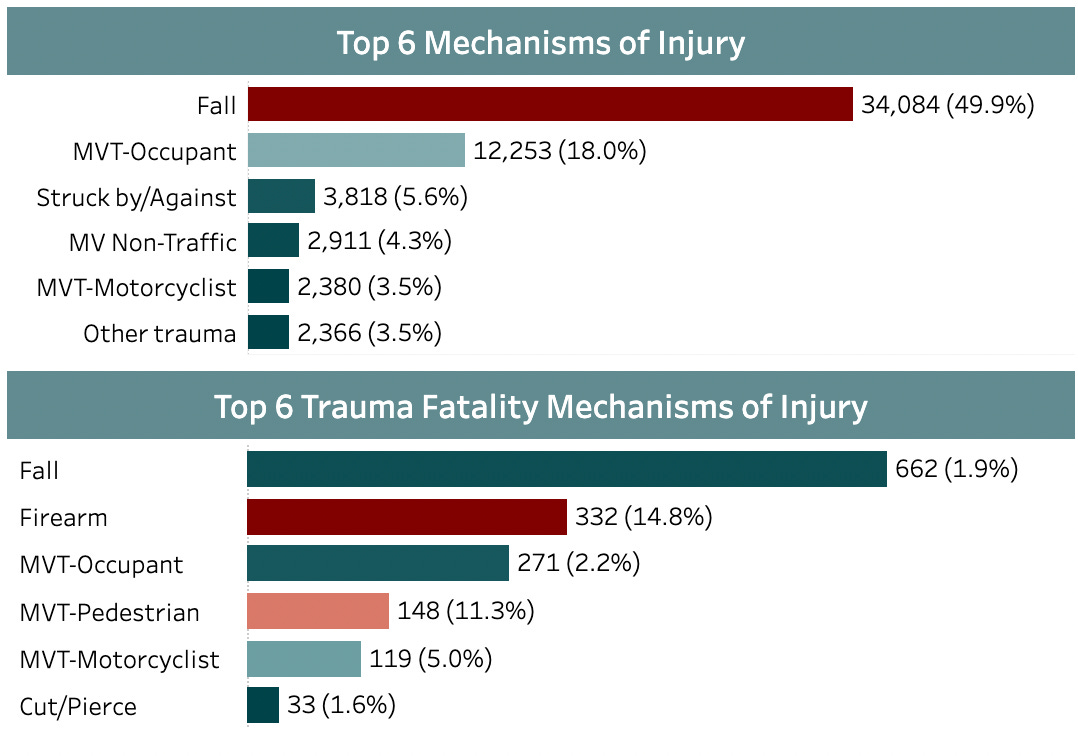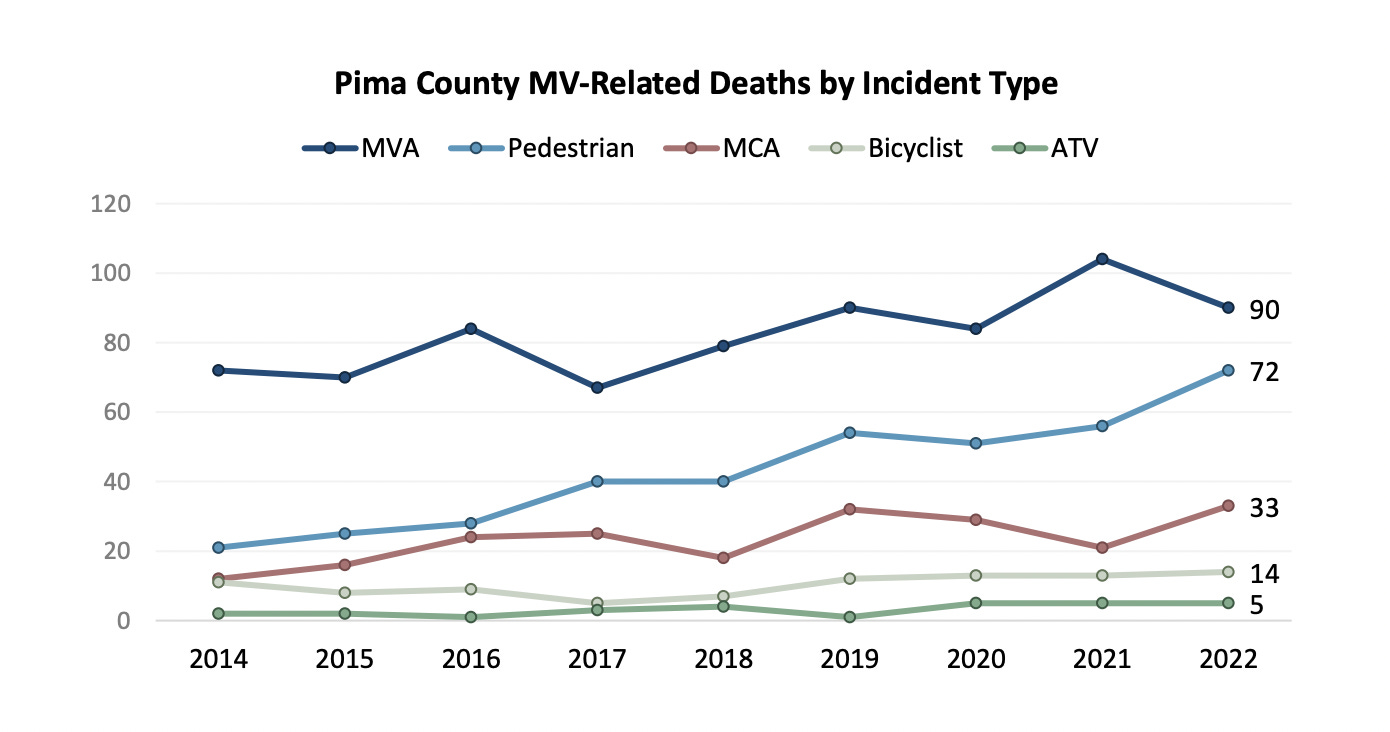The Daily Agenda: Disasters, death and data
The state rolled out a new set of trauma data dashboards … Officials say these could help shape future prevention efforts … Tucson’s January 6 siblings plead guilty.
If you’re at all familiar with the Tucson Agenda, you know we’re big fans of data visualization, especially in the form of online dashboards designed for the public to use.
Since our launch in July, we’ve written about data dashboards from the University of Arizona, City of Tucson and Pima County that cover housing, local deaths, equity and more. Now we have another one to tell you about.
Earlier this week, the Arizona Department of Health Services unveiled its new trauma dashboards that offer a detailed look at how many times people call 911 or end up in the emergency room, along with injuries related to falls and motor vehicles. All of it is broken down by year, race and ethnicity.
The dashboards also include injuries and deaths reported to the Arizona State Trauma Registry from 2017 through 2022 due to firearms, sharp objects, bites and stings, assault, physical abuse and more.
The data shows that many of these incidents are preventable, either through the use of safety measures like seatbelts and helmets or through education on risk factors.
Although a significant number of these injuries or deaths can be avoided, the rates increase year over year. The dashboards show a 4% rise in incidents and a 3% increase in trauma-related deaths from 2021 to 2022.
There’s also local evidence of that increase, with the medical examiner’s office recording the highest-ever number of motor vehicle-related deaths in 2022, with 214.
While the department of health services has been gathering this type of information and generating reports for years, this is the first time the data has been presented in a way meant for the public to understand. Officials say the dashboards can help identify trends, risks, protective factors and hopefully, additional opportunities for prevention.
WithIn Pima County last year, there were 8,966 trauma incidents, including 878 assaults and 2,583 injuries from motor vehicle collisions.
The data shows that Pima County was below average compared to the rest of the state for injuries from crashes, but above average when it comes to traffic-related fatalities.
Some other key statewide findings include:
Falls were the top cause of injury and death for people over the age of 65, with 23,826 fall injuries and 554 deaths.
This age group also had the highest trauma rate, and the rate of trauma incidents is significantly higher for American Indian or Alaska Native people across all age groups.
For kids and teens, falls were the leading cause of injury, but firearms were the leading cause of death.
In 2022, 26 kids or teens died from firearm-related injuries, representing 1/3 of the total pediatric deaths.
Thirty kids and teens died in motor vehicle crashes and seven died as the result of child abuse.
Substance use or alcohol as a factor in motor vehicle crashes statewide decreased slightly from 2022 to 2021.
But, both are still higher than 2017, when substance use was suspected or confirmed in 17.3% of crashes and alcohol in 13.6%.
Last year, suspected or confirmed substance use was a factor in 21.5% of crashes and alcohol in 16.2%.
Alcohol and illicit substances played a big role in overall traumas across the state, with nearly 24% of all trauma incidents in 2022 involving suspected or confirmed use.
And in what will likely come as no surprise, traffic fatalities are high across the state. But the dashboards offer a deeper look into the circumstances and can show how risk factors and protective measures can increase or reduce the extent of a person’s injury.
The data shows (and has shown for years) that seatbelts and helmets can greatly reduce the level of injury and dramatically increase a person’s chance of survival. Last year, people involved in vehicle crashes who weren’t wearing seatbelts were four times more likely to die compared to people who were wearing seatbelts.
But many people still aren’t taking these simple measures to protect themselves, according to the dashboard, which showed that in 2022, less than half of motorcyclists involved in a crash were wearing helmets. Research has shown that motorcyclists are twice as likely to die from injuries if they’re not wearing a helmet.
ADHS officials say that the dashboards back up the need for basic, but effective, prevention methods, including education surrounding firearm safety, fall prevention and the use of seatbelts and helmets.
But that sort of messaging has been around for years, and these types of incidents still occur with frequency and in many cases, are happening more often. Motor vehicle collisions and firearm-related deaths and injuries are increasing each year, despite public education campaigns, changes in legislation and widespread efforts by governments and community groups.
Finding effective solutions to things like traffic safety and gun violence is proving to be a monumental task, so if officials think that visualizing data in this way can help, this new dashboard is a welcome addition.
If you’re enjoying our coverage, how about sharing the Tucson Agenda with a friend?
To build or not to build: A zoning battle is going down in Oro Valley, over the proposed rezoning of a section of land at the corner of Tangerine and Rancho Vistoso, KGUN’s Kenny Darr reports. Some nearby residents say that putting several hundred high-density housing at an already busy intersection creates traffic safety issues, but the developer said that housing in the area is in high-demand. The next meeting in this yearslong rezoning debate will take place on Nov. 9.
Capitol riot update: A pair of Tucson siblings pleaded guilty Wednesday for their involvement in the January 6 attack on Congress by supporters of Donald Trump, the Tucson Sentinel’s Paul Ingram writes. Felicia Konold and Cory Konold each pleaded guilty to a single count of obstructing, impeding or interfering with law enforcement during the commission of a civil disorder. They each face up to five years in prison and a fine of $250,000. Their sentencing is scheduled for January.
Verdict rendered: The family of late Gov. Raúl Castro has been awarded a six-figure settlement from the Arizona Board of Regents over the University of Arizona’s attempts to sell Castro’s Nogales home, which was meant to be used as an academic space, the Arizona Daily Star’s Ellie Wolfe reports. In 2015, the family agreed to convey the home to the school to use it to create a border studies program named after Castro, but in February, the UA changed course and listed the house for sale for $300,000.
On the defense: Raytheon’s Tucson office was the site of a Thursday protest by a coalition representing “progressive Jewish anti-Zionist” and pro-Palestine organizations, the Arizona Republic’s Sarah Lapidus writes. The group of about 60 protesters clad in black with face masks staged a “die-in,” lying down on the pavement and blocking the facility’s entrance. Organizers say they targeted Raytheon because it’s the largest private employer in Tucson and the company held the no. 2 spot in defense revenues in 2022.
Grass be gone: The City of Tucson will be replacing 55,000 square feet of city turf with desert plants and trees, thanks to $1.5 million in state funding to create a new turf removal program in 2024, Arizona Public Media’s Carly Siegel reports. The program aims to find efficient ways of promoting water conservation for parks and private property owners. It also plans to replace 200,000 square feet of turf with landscaping to help businesses and apartment complexes. The plan is part of the city’s Drought Preparedness and Response Plan, Plan Tucson and the One Water 2100 Plan.
A neverending story: The Sentinel’s Blake Morlock breaks down the history and most recent changes to the Rio Nuevo Multipurpose Facilities District Board, in the wake of Gov. Katie Hobbs’ decision last month to make four new appointments. Tucson Metro Chamber CEO Michael Guymon, who has history with the project dating back to the mid-90s, says he’s concerned that playing politics with the project could take it back to a bad place, but Rio Nuevo board chairman Fletcher McCusker says people just need to relax.
"It's naive to think that the governor isn't going to use her appointments to put her stamp on things,” McCusker said.
24: The number of paid subscribers the Tucson Agenda needs to hit 500. We’re also a day away from our four-month anniversary. We’d love to celebrate by reaching the 500 paid subscriber mark.











Another great post. One story among several that caught my eye - disposition of the Castro home in Nogales. It reminded me of the UA's betrayal of a promise to JT Page when he deeded his ranch to UA in return for continuity of his vision for sustainable agraculture and water harvesting. The UA turned Page Ranch into a toxic waste disposal site. Talk about betrayal of a commitment! BTW I write about it in frankpierson.substack.com